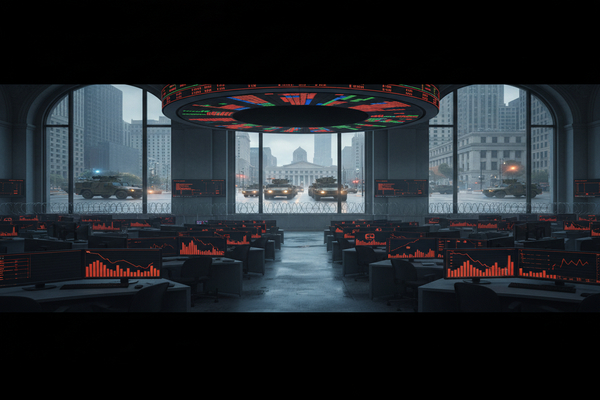
Opening snapshot
How today’s headlines set the tone for trading
The announcement that US troops are preparing for deployment to Chicago and the accompanying political confrontation between the White House and local officials will frame investor attention as markets open. The president publicly called for jailing Chicago’s mayor and the governor of Illinois. Neither official has been accused of criminal wrongdoing. At the same time, hundreds of Texas National Guard soldiers have gathered at an Army facility outside Chicago. A recent Reuters Ipsos poll shows most Americans oppose sending troops into US cities when there is no external threat. These developments add a fresh layer of uncertainty to an already sensitive policy calendar and are likely to be the primary driver of sentiment in the early trading session.
Equities and risk appetite
Political conflict pushes risk assets into cautious territory
Equities are likely to open under pressure as traders price in increased political risk and the possibility of domestic unrest. Headlines that describe a federal troop presence in a major city raise concern about social disruption and consumer behavior. Market participants typically respond to heightened political conflict by reducing exposure to cyclical and high-beta names. Regional banks, retailers with heavy exposure to Chicago, and companies with significant local operations can see larger moves than the broader market because of perceived operational or demand risk. Large cap defensive names may outperform in a risk-off environment as investors rotate into perceived safety within the equity universe.
Fixed income and safe-haven flows
Yields likely to move as investors seek shelter
Bond markets tend to react quickly to spikes in risk aversion. US Treasury yields are likely to fall as demand increases for government paper. A movement into Treasuries would push short- and intermediate-term yields lower and flatten yield curves if persistent. Gold and other traditional safe-haven assets typically attract inflows when political uncertainty rises. Traders should watch intraday flow patterns for evidence that the market is re-pricing macro risk premia. The poll showing public opposition to deploying troops could influence how sustained that re-pricing becomes, as political backlash can amplify uncertainty for longer than the initial headline reaction.
Regional credit and municipal bonds
Illinois and Chicago exposures deserve attention
The concentration of troops around Chicago and the political showdown with state leaders have particular relevance for municipal markets and any financial instruments tied to Illinois or the city of Chicago. Even though neither the mayor nor the governor faces criminal allegations, the rhetoric and the physical presence of Guard units can create market anxiety about local governance and fiscal management. Municipal yields for Illinois or Chicago-related credits could widen relative to peers as investors demand compensation for increased political risk. Traders and portfolio managers with municipal portfolios should monitor spreads and be ready for idiosyncratic moves in city or state credits.
Sectors most likely to move
Where to look for outsize reactions
Certain sectors are more sensitive to domestic security developments. Regional financial institutions may trade with higher volatility if market participants anticipate deposit shifts or local economic impacts. Consumer discretionary and travel related firms with large footprints in Chicago might see near-term demand concerns reflected in their prices. Industrial and defense related suppliers may receive some attention because of the practical implications of troop movements, although any such effect is likely to be more muted in the absence of concrete federal contracting news. Stay focused on intraday volume patterns and relative performance between local exposure names and their national peers.
Volatility and derivatives
Use options and futures to manage directional risk
Given the potential for sudden headline-driven swings, volatility measures should be monitored closely. Traders looking to hedge exposure or take advantage of repricing can consider options strategies to manage downside risk or to express a view in a defined-risk way. Futures markets will also reflect the initial sentiment shift and can provide a guide to how broader markets may perform at the open. Be mindful of liquidity which can dry up quickly in heightened risk periods and cause larger moves than fundamentals alone would justify.
Practical trading checklist for the session
Key items to watch and where to position
Start the session with a clear plan for position sizing and stop levels. Watch headline flow and the pace of official statements for signs of escalation or de-escalation. Monitor Treasury yields and gold as barometers of investor risk appetite. Keep an eye on municipal bond spreads for Illinois and Chicago related credits. Look at intraday leadership to see whether the market is moving toward defensive positioning or whether buyers emerge to test downside. Finally, be prepared to adjust exposure quickly if the news cycle changes, as political developments can alter sentiment on short notice.
Final observations
Expect a news driven session with concentrated risks
Today’s developments create a news driven trading environment that could push volatility higher. The combination of federal troop preparations and pointed political rhetoric introduces an element of domestic policy risk that markets do not price every day. Investors should approach the session with heightened discipline, focusing on liquidity, position sizing, and contingent plans for both risk reduction and opportunistic entries. Watch how public sentiment, reflected in the poll, interacts with official actions because sustained public opposition could prolong uncertainty and broaden the market impact beyond initial reactions.












